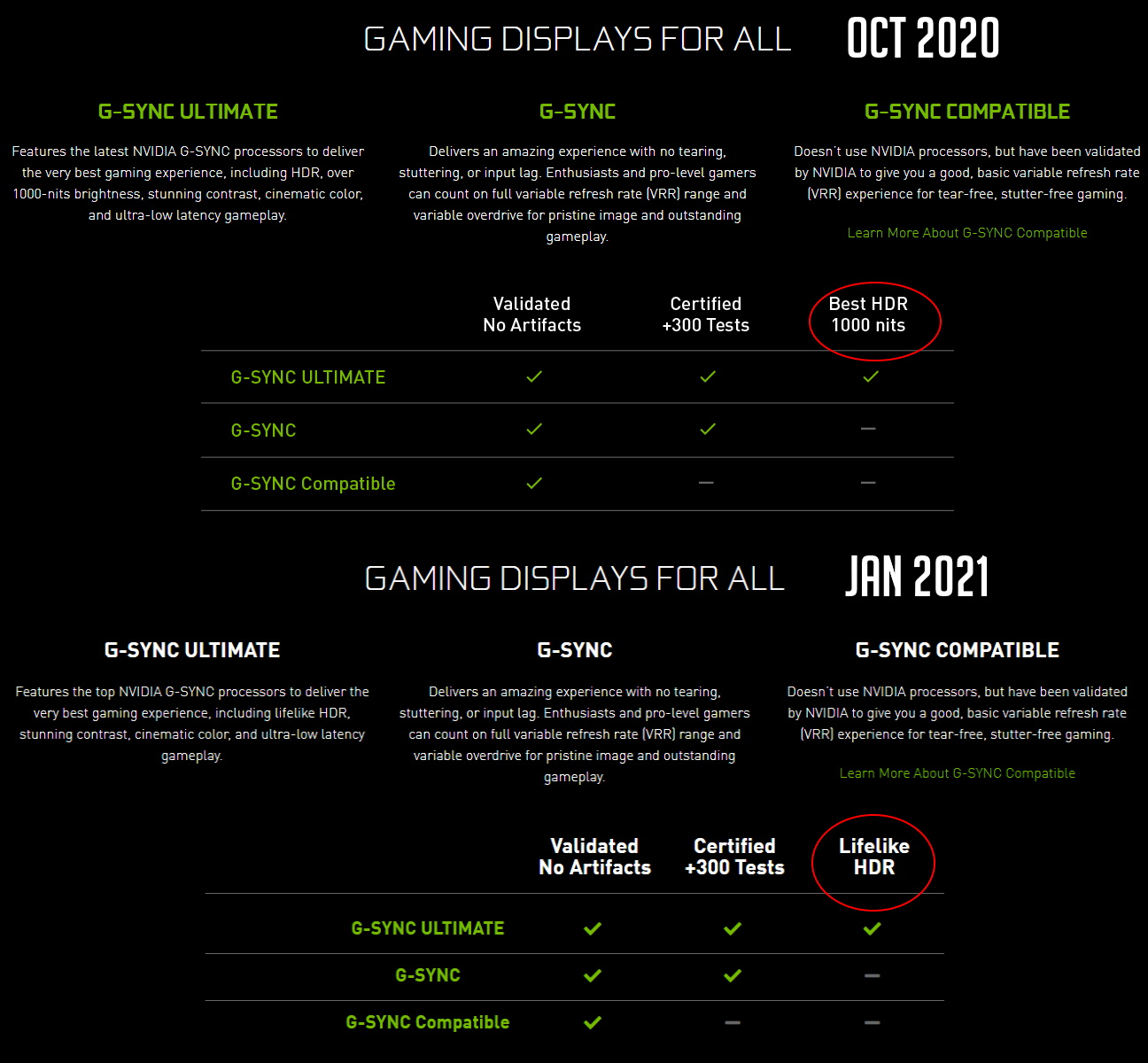Nvidia Silently Changes Its G-Sync Ultimate Requirements
It's been observed by PC Monitors and noticed when comparing Nvidia's G-Sync page today to that of November 2020, that Nvidia has quietly eased its requirements for a monitor to be classified as a G-Sync Ultimate monitor.
During CES 2021 and during Nvidia's live stream, several new monitors were announced; ASUS PG32UQX, LG 34GP950G, and the MSI MEG381CQR. Two of those monitors listed are classified as VESA DisplayHDR 600 (600 maximum nits brightness) and received Nvidia's G-Sync Ultimate badge.
This is quite a change from the original requirements for a monitor to be classified as a G-Sync Ultimate monitor. For any monitor to be classified as a G-Sync Ultimate monitor, it had to provide the following benefits;
- 1000 nits brightness (DisplayHDR 1000)
- highest resolution highest Hz
- Ultra-low latency
- Multi-zone backlight
- Wide color gamut
- Advanced NVIDIA G-Sync processor
With the newly announced monitors from CES 2021 now being touted as G-Sync Ultimate monitors, It's clear that there was a change that Nvidia had failed to mention. This has caused some confusion and prompted PC Monitors to tweet out to Nvidia regarding the change.
Would be helpful if @nvidia could clarify what 'G-SYNC Ultimate' actually means. It used to be VESA DisplayHDR 1000 with FALD. Then applied to some VESA DisplayHDR 600 models. And now you've certified some VESA DisplayHDR 400 models as 'G-SYNC Ultimate'? https://t.co/4DTcv3ikkXJanuary 17, 2021
And while Nvidia didn't mention the change, it was rolled into the press release that followed Nvidia's CES 2021 event. Along with the new announcements was the updated revision for its G-Sync Ultimate classification. Gone is the DisplayHDR 1000 requirement, and now replaced with the following;
"G-SYNC ULTIMATE Gaming Monitors: The highest-grade G-SYNC monitors available, with G-SYNC Processors, the latest panel technologies, excellent HDR (up to 1400 nits), and the latest advancements, such as Mini-LEDs."
Nvidia also updated its website, which highlights the change. It no longer mentions "1000 nits" as a benefit, replaced by "Lifelike HDR." That said, it is much easier to argue that something looks lifelike, instead of saying this monitor does provide you with a specific tier of performance.
Get Tom's Hardware's best news and in-depth reviews, straight to your inbox.
You can see the change in the image below.

Currently, Nvidia hasn't stated why the change was made, so we don't officially know. However, it could simply come down to pricing. It's no secret that the prior G-Sync Ultimate monitors were expensive and that's due to the DisplayHDR level. With Nvidia changing up its requirement, this could open the door for cheaper monitors to bear the G-Sync Ultimate classification. But at the same time, this will also add some fragmentation into the mix as the classification could be applied to monitors from DisplayHDR 400 and up.

Keith Mitchell is a Contributing Writer for Tom's Hardware US. He is an IT professional during the day, and a passionate lover of video games and tech after his 9-5 grind. He has a weird affinity for Soulsborne games and plays them non-stop.
-
dmoros78v ReplyNP said:It should be illegal to refer to anything below HDR1000 as "HDR". Period.
LG OLED CX, one of the bests TVs on the market today reach a maximun of 800 nits and only at a 10% white window, so I dont truly agree with your statement, the black level is as important as the peak brightness for defining the dynamic range and OLED on a dark room is on a whole different level of performance even if not reaching 1000 nits (which matters most in bright rooms)